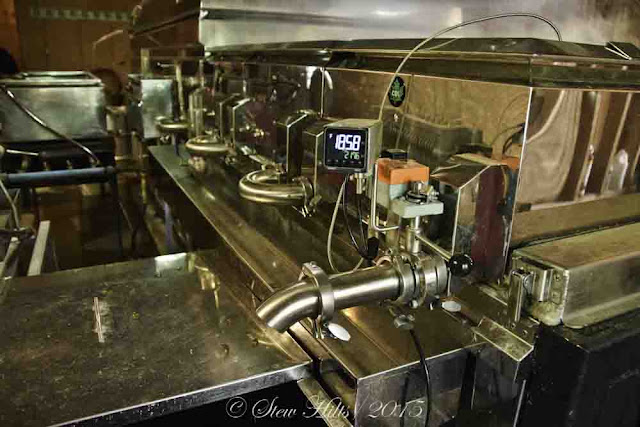The important thing comes first of course - a litre of beautiful sweet maple syrup like this - but it takes a long way to get there! I'll have a lot of pictures this week, since we visited 6 different size operations, and this is the largest, so the story here is the detailed version for those of you who asked.
These Maple Sugar bush owners tap 6000 trees, the largest operation I've ever seen, and it provides a full-time, year-round occupation and income. Very few maple syrup operations are this size, and some are very small!
It starts of course in the woods, here about 100 acres of trees tapped, all joined with plastic tubing that stays in place, though each spile in every tree has to be replaced every year.
The other raw product is wood, mostly Ironwood, which in this operation is all chipped, another unique feature here. Getting the wood is one of the big tasks over the year, and it comes from managing additional lands to move them toward maple syrup production for the future by eliminating Ironwood and encouraging Sugar Maple growth. The chips are dumped into the big wagon, and then move up the chute into the 'sugar shack'. The oil drums are for storing maple syrup.
On the inside they fall down this chute,
and are moved automatically by this auger, into the burner beneath the huge evaporator. The firewood is left to season for a year before use, so they are cutting their supply two years ahead.
Meanwhile, the sap, which has been sitting in huge storage vats, is run through this reverse-osmosis filter. Essentially this reduces the water content, and increases the sugar content. It can do this because water molecules are far smaller than sugar molecules. Sap comes in from the trees at about 2% sugar; after this process it is at 10% sugar, and when the whole process is finished it is 66% sugar which is the legal requirement in Ontario. However, the reverse osmosis process reduces the boiling time in the evaporator by about 75%, a huge gain.
This is the evaporator, the biggest I've ever seen. The sap works its way slowly through channels inside while it is brought to a boil by the fire underneath. Two of the big pipes through the roof are steam vents; the other is the chimney for the firebox. The square boxes on the left are where the sap is finished off. For every 40 gallons of sap you get one of syrup, so there are 39 gallons of water to boil off.
The sap is drawn off in this corner after it has worked its way through the evaporator, where they watch for the correct temperature, the key thing to watch for while making syrup. We made syrup ourselves on a very small scale years ago, so we understand how critical this step is!
This is the temperature gauge they watch. The sap is at 186.2F. now, and they will wait til it hits 217.6 F. (5 degrees above the boiling point of water) before drawing it off.
It is pumped from that first pan through this series of filters.
Then it carries on into that rectangular pan on the right side of this photo. You can see that they store their syrup production not in bottles, but in 55 gallon steel drums. They will bottle it over the year as they go out to various different local markets to sell it.
The final syrup is drawn off here into a big steel drum. At this point they are measuring the 'brix' content (the means of measuring sugar content) very carefully, in order to hit that 66% right on. If it gets to 68% you can have sugar crystal deposits on the bottom of the bottles.
And so to the final product - maple syrup for sale!
Over the next few days we'll visit several other smaller operations, and we'll also see some of the animals on these farms - which range from Highland Cows to Elk.














Great photos & I too would have found that tour very interesting & especially would have loved that big pancake breakfast for sure:))
ReplyDeleteWow - that's really interesting! I'll bet that maple syrup is delicious!
ReplyDeleteNo wonder it costs so much! It's so beautiful to look at, and even more wonderful to ingest. I look forward to more. :-)
ReplyDeleteYears ago we had a young lady call in, wanting an address of someone else. She had worked in the Canadian Government, and as a wonderful unexpected thankyou for my troubles, gave us a beautiful bottle of the " Real Dinkum" Canadian Maple Syrup. I have not tasted anything as good since. 100 acres, that is a whopping area to manage. Love all the details and facts.Enjoy those pancakes.
ReplyDeleteNothing quite like yeah maple syrup, what an amazing process.
ReplyDeleteThanks for showing this.....the colour is glorious!
ReplyDeleteHello, interesting post on the maple syrup process. Great tour and photos. The breakfast sounds yummy too. Happy Sunday, enjoy your new week ahead!
ReplyDeleteBeautiful! Can't beat maple syrup!
ReplyDeleteYUMMY ! It is quite the operation they have set up these days for maple syrup only a hand full of syrup farmers do it the old fashioned way . Nothing like fresh Canadian maple syrup . Great post and photos . Lots of snow still up that way , more snow on the way more for the north horse shoe area and snow belt less for us then it will change to rain next weeks forecast looks wonderful this is the last blast of snow they say . Thanks for sharing , Have a good day !
ReplyDeleteFascinating to see things behind the scenes. Maple syrup is of course one of life's great pleasures!
ReplyDeleteQuite an operation. The pancake breakfast sounds wonderful. : )
ReplyDelete